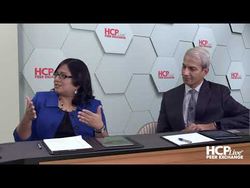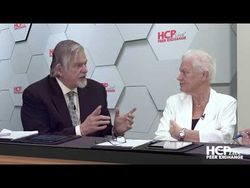Management of Beta Thalassemia - Episode 15
Pipeline Agents for the Treatment of Beta-Thalassemia
Peter L. Salgo, MD: We have a little time left. I don’t want to leave the discussion without talking about JAK2 inhibitors. Where do they fit in this whole beta-thalassemia problem?
Farzana Sayani, MD: They were looked at, and it didn’t work.
Peter L. Salgo, MD: Are we done? That’s it? Question answered?
Farzana Sayani, MD: In preclinical studies it was exciting because the erythroid cells had JAK2 on them, and you could use JAK2 inhibition and reduce changes to the erythropoiesis. But they did do a phase II study, which showed that the spleen shrunk but there was no real change in the hemoglobin or their pretransfusion hemoglobin.
Peter L. Salgo, MD: Not really.
Farzana Sayani, MD: No.
Peter L. Salgo, MD: Can I actually say this? I’m going to try this. They’re not worth jack.
Farzana Sayani, MD: Good one.
Peter L. Salgo, MD: In any event, so that’s it: we’re not going to use JAK2, right? OK. Are there agents in the pipeline?
Maria Domenica-Cappellini, MD: There is a long pipeline of new drugs targeting the ineffective erythropoiesis. But what is really new are several compounds, which will control the iron metabolism. And they are hepcidin mimetic; hepcidin is the actor driving all the movement into the body. Macrophage to related compounds, which is intriguing because the way they probably work is to modulate the atom distribution in the body, making an iron-deficient erythropoiesis that, at the end of the day, will be also affecting the ineffective erythropoiesis.
Peter L. Salgo, MD: That’s to come. Anything else in the pipeline?
Sujit Sheth, MD: There’s the whole hepcidin modification. Then there is some interest in the PKLR drug, the pyruvate kinase inducer. That might also target the ineffective erythropoiesis and improve your erythropoiesis as a result of upregulating the pyruvate kinase.
Peter L. Salgo, MD: Forgive me. You’re speaking to someone who is not a hematologist. Why? Why are we looking at all these other pathways when we have cures?
Thomas D. Coates, MD: Well, probably in the intermediate patients is where these things may have impact. Maybe there are some patients—I don’t know. I see Nica shaking her head, and I’m sort of shaking along with her.
Peter L. Salgo, MD: Shaking about what?
Thomas D. Coates, MD: I’m not sure how important these are going to be.
Maria Domenica-Cappellini, MD: I think that since the new era for treatment of these patients has started, there is a lot of interest in looking at different drugs and so on. At the end of the day, I personally believe that the way to achieve a result is to correct the alpha and beta and balance it to correct erythropoiesis. The imbalance can be corrected with the gene therapy or bone marrow transplantation, and the ineffective erythropoiesis so far can be corrected with the luspatercept. All the others, especially those working on iron, could be TKTK. For the future—I will not be working any more at that time— I’m looking at combination treatments as a possibility.
Farzana Sayani, MD: And also it’s access. Gene therapy, bone marrow transplant is not easily accessible to where the significant burden of disease is in the developing countries.
Peter L. Salgo, MD: That’s, I think, where I was going.
Farzana Sayani, MD: And so if we have oral agents, if we have these pharmaceutical agents, you could use them in combination.
Maria Domenica-Cappellini, MD: Combo.
Peter L. Salgo, MD: Theoretically less experience, theoretically less cumbersome, and if not, everybody in less developed parts of the world can get high-tech medicine, they could be used.
Thomas D. Coates, MD: I mean, your comment on cost, this is a whole other conversation that we don’t have time to go into.
Peter L. Salgo, MD: Oh, we have plenty. Go ahead.
Thomas D. Coates, MD: I was quite surprised when 1 of my patients told me that, of course, the United States is far more expensive than anyplace else. The chelators, these oral chelators, can be $40,000 to $50,000 a year.
Peter L. Salgo, MD: I’m shocked. Really?
Thomas D. Coates, MD: Yes. And all of these new drugs—I don’t know what the cost of luspatercept is going to be, but it’s not going to be $10 a month. I’ve seen pharmacoeconomic data, and actually when you look at the cost of bone marrow transplant compared with—life expectancy, in my mind, for thalassemia patients is probably near normal now if they’re properly managed. And so we’re talking about 7 decades of chelation required. And so bone marrow transplant becomes a financially good choice for many of these patients.
Peter L. Salgo, MD: I was shocked at the number that you quoted for bone marrow transplant. It was very low by comparison.
Thomas D. Coates, MD: In the United States it’s $200,000.
Peter L. Salgo, MD: You know, $50,000 for chelating agents is a lot of money.
Sujit Sheth, MD: It’s not just chelation. We actually looked at the cost, and it costs about $130,000 a year to take care of an adult thalassemia patient. About half that is chelation, about half that is the transfusions themselves, and then a small amount of all the monitoring and the blood tests, the MRIs [magnetic resonance imaging tests], and all that stuff. If you look at the cost and say it costs $130,000 a year, that’s $1.3 million a decade. For 7 decades, do the math. We’re talking about $9 million.
Peter L. Salgo, MD: Per patient?
Sujit Sheth, MD: Per patient.
Maria Domenica-Cappellini, MD: Per patient, yes.
Sujit Sheth, MD: If you can get something like a curative therapy, for instance, that costs less than that, it might still be worthwhile.
Maria Domenica-Cappellini, MD: And if we didn’t capture too much of the quality of life. That is the other point.
Peter L. Salgo, MD: Sure. The quality of life, if you don’t need therapy, don’t need transfusions, don’t need chelation—with all due respect, don’t have to see you guys all the time? It’s better, no?
Maria Domenica-Cappellini, MD: Of course.
Thomas D. Coates, MD: Children are very adaptive, and they come in for their transfusions every 3 weeks. But if I think about having to spend a whole day in the hospital every 3 weeks to get a transfusion—the families seem to—that becomes their normal, but in fact it isn’t normal.
Transcript edited for clarity.



